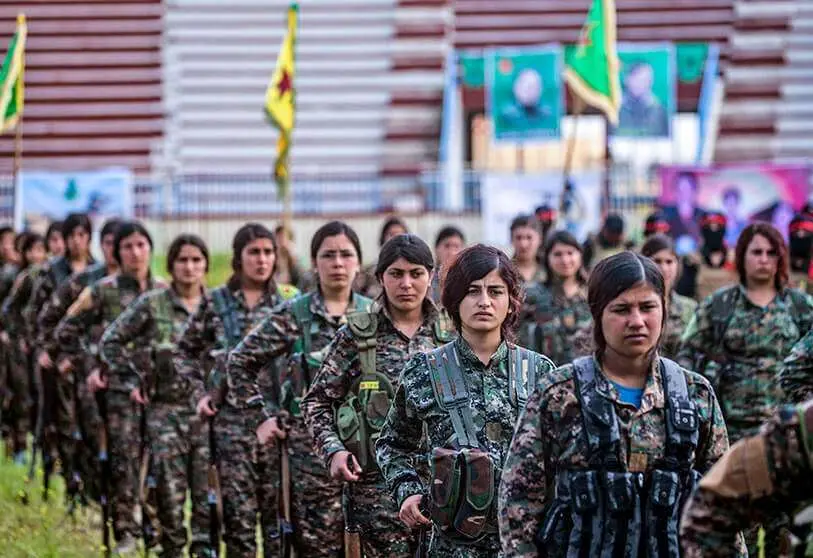How Kurdish feminism brought down Daesh

Kurdish women, guided by the ideology of 'jineology', began their own struggle for liberation in the 1990s. They are victims of a male chauvinist system that dominates Kurdistan, an area in which honour killings against women and female genital mutilation, among others, are still permitted to this day; they are concentrated in the regions of Afrîn, Cizîre and Kobane1.
We can consider the creation of the Women's Army (later known as the YJA-Star) as the first women's guerrilla against patriarchal liberation in the region. However, the military sphere has always been reserved for men.
The Peshmerga, the mostly male Kurdish guerrillas, are one of the main, if not the biggest, opposition force against Daesh. The Kurdish people's sense of struggle and liberation has spread throughout the population, involving both men and thousands of women, who, bypassing the established patriarchal laws, have come to form the first counter-terrorist front.
In 2013, the "female" branch of the YPH (all-male People's Protection Units) of the Democratic Union Party (PYD) was born: the Women's Protection Units (YPJ), whose main objective was based on the achievement of a shared leadership between men and women, including in the political-military sphere.
Their feminist discourse became even stronger after Daesh took control of Kobane in 20142. the establishment of their system of extreme patriarchy, with forced marriages, death by stoning, ablation and trafficking of women for sexual purposes, was the trigger for these female guerrillas to harden their struggle. Thousands of women have been kidnapped, raped and subsequently sold in bazaars or to prostitution mafias at prices of no more than 100 dollars per person. Not only that, if they have managed to escape, these women have taken the decision to commit suicide or have been killed by their own families upon returning to their communities because of the dishonour they brought upon themselves3. This is the 21st century.
In 2018, they already numbered more than 30,000 members4, constituting 50-60% of the resistance ranks in Kobane. Among the main characteristics of the YPG and the YPJ is the fact that the defence of the city is always led by two people, a woman and a man, sharing responsibilities at all times.
In addition to demonstrating female empowerment in the area, breaking with classic stereotypes, they are a double-edged sword that frightens Daesh jihadists: the fear of dying at the hands of a woman. It is not, however, a fear that stems from the recognition of their capabilities, but quite the opposite, it is their macho belief in gender inferiority, the dishonour of dying for a woman and the impossibility of accessing paradise5.
This feminist movement has influenced many other societies in the Middle East. As one of its women warriors recounts: "When we joined the guerrilla it was our family who accompanied us to join our comrades. This is something new. Normally it was frowned upon for girls to get involved in these things. But our family understood that this is the way to protect our honour and our land. As Commander Sengal rightly says: "The Kurdish guerrillas have been an important milestone in the struggle for women's freedom. Our war is not only against the Islamic State, but against all kinds of inequalities6.
These women are not only fighting against Daesh, but also against the machism inherent in the culture, which is why their ranks are no longer only made up of Kurdish women, but are now joined by Muslim women of various ethnicities7.
Amanda Pérez Gómez, criminologist specialising in international terrorism.
Bibliographical references:
1. Gámez, L. (2016). Kurdas en lucha contra el patriarcado y el Estado Islámico. Pikara
2. emol. (15 de Octubre de 2014). Mujeres kurdas toman las armas contra ISIS en la batalla por Kobane. emol.
3. Gámez, L. (2016). Kurdas en lucha contra el patriarcado y el Estado Islámico. Pikara.
4. Belinchón, G. (6 de Noviembre de 2018). La guerra de las mujeres contra el ISIS. El País.
5. Inza, B. P. (2014). Mujeres peshmerga - "Las que enfrentan la muerte" - y mujeres yihadistas. Ieee.
6. Mourenza, A. (2014). Las heroínas de Kobani. El periódico.
7. Belinchón, G. (6 de Noviembre de 2018). La guerra de las mujeres contra el ISIS. El País.
